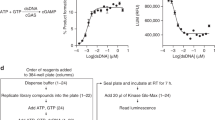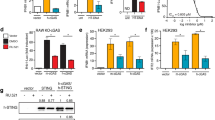Abstract
Enhancing production of the anti-inflammatory cytokine interleukin-10 (IL-10) is a promising strategy to suppress pathogenic inflammation. To identify new mechanisms regulating IL-10 production, we conducted a phenotypic screen for small molecules that enhance IL-10 secretion from activated dendritic cells. Mechanism-of-action studies using a prioritized hit from the screen, BRD6989, identified the Mediator-associated kinase CDK8, and its paralog CDK19, as negative regulators of IL-10 production during innate immune activation. The ability of BRD6989 to upregulate IL-10 is recapitulated by multiple, structurally differentiated CDK8 and CDK19 inhibitors and requires an intact cyclin C–CDK8 complex. Using a highly parallel pathway reporter assay, we identified a role for enhanced AP-1 activity in IL-10 potentiation following CDK8 and CDK19 inhibition, an effect associated with reduced phosphorylation of a negative regulatory site on c-Jun. These findings identify a function for CDK8 and CDK19 in regulating innate immune activation and suggest that these kinases may warrant consideration as therapeutic targets for inflammatory disorders.
This is a preview of subscription content, access via your institution
Access options
Access Nature and 54 other Nature Portfolio journals
Get Nature+, our best-value online-access subscription
$29.99 / 30 days
cancel any time
Subscribe to this journal
Receive 12 print issues and online access
$259.00 per year
only $21.58 per issue
Buy this article
- Purchase on Springer Link
- Instant access to full article PDF
Prices may be subject to local taxes which are calculated during checkout




Similar content being viewed by others
Accession codes
References
Saraiva, M. & O'Garra, A. The regulation of IL-10 production by immune cells. Nat. Rev. Immunol. 10, 170–181 (2010).
Shouval, D.S. et al. Interleukin 10 receptor signaling: master regulator of intestinal mucosal homeostasis in mice and humans. Adv. Immunol. 122, 177–210 (2014).
Asadullah, K., Sterry, W. & Volk, H.D. Interleukin-10 therapy--review of a new approach. Pharmacol. Rev. 55, 241–269 (2003).
Braat, H. et al. A phase I trial with transgenic bacteria expressing interleukin-10 in Crohn's disease. Clin. Gastroenterol. Hepatol. 4, 754–759 (2006).
Galeazzi, M. et al. A phase IB clinical trial with Dekavil (F8-IL10), an immunoregulatory 'armed antibody' for the treatment of rheumatoid arthritis, used in combination wiIh methotrexate. Isr. Med. Assoc. J. 16, 666 (2014).
Rodríguez, M. et al. Polarization of the innate immune response by prostaglandin E2: a puzzle of receptors and signals. Mol. Pharmacol. 85, 187–197 (2014).
Martin, M., Rehani, K., Jope, R.S. & Michalek, S.M. Toll-like receptor-mediated cytokine production is differentially regulated by glycogen synthase kinase 3. Nat. Immunol. 6, 777–784 (2005).
Clark, K. et al. Phosphorylation of CRTC3 by the salt-inducible kinases controls the interconversion of classically activated and regulatory macrophages. Proc. Natl. Acad. Sci. USA 109, 16986–16991 (2012).
Sundberg, T.B. et al. Small-molecule screening identifies inhibition of salt-inducible kinases as a therapeutic strategy to enhance immunoregulatory functions of dendritic cells. Proc. Natl. Acad. Sci. USA 111, 12468–12473 (2014).
Wang, B. et al. Microtubule acetylation amplifies p38 kinase signalling and anti-inflammatory IL-10 production. Nat. Commun. 5, 3479 (2014).
Na, Y.R. et al. The early synthesis of p35 and activation of CDK5 in LPS-stimulated macrophages suppresses interleukin-10 production. Sci. Signal. 8, ra121 (2015).
Souto, A. & Gómez-Reino, J.J. Apremilast for the treatment of psoriatic arthritis. Expert Rev. Clin. Immunol. 11, 1281–1290 (2015).
Gordon, J.N. et al. CC-10004 but not thalidomide or lenalidomide inhibits lamina propria mononuclear cell TNF-α and MMP-3 production in patients with inflammatory bowel disease. J. Crohns Colitis 3, 175–182 (2009).
Xing, L., Rai, B. & Lunney, E.A. Scaffold mining of kinase hinge binders in crystal structure database. J. Comput. Aided Mol. Des. 28, 13–23 (2014).
Allen, B.L. & Taatjes, D.J. The Mediator complex: a central integrator of transcription. Nat. Rev. Mol. Cell Biol. 16, 155–166 (2015).
Bancerek, J. et al. CDK8 kinase phosphorylates transcription factor STAT1 to selectively regulate the interferon response. Immunity 38, 250–262 (2013).
Shi, J. et al. Scalable synthesis of cortistatin A and related structures. J. Am. Chem. Soc. 133, 8014–8027 (2011).
Pelish, H.E. et al. Mediator kinase inhibition further activates super-enhancer-associated genes in AML. Nature 526, 273–276 (2015).
Mallinger, A. et al. Discovery of potent, selective, and orally bioavailable small-molecule modulators of the mediator complex-associated kinases CDK8 and CDK19. J. Med. Chem. 59, 1078–1101 (2016).
Kwiatkowski, N. et al. Targeting transcription regulation in cancer with a covalent CDK7 inhibitor. Nature 511, 616–620 (2014).
Li, N. et al. Cyclin C is a haploinsufficient tumour suppressor. Nat. Cell Biol. 16, 1080–1091 (2014).
O'Connell, D.J. et al. Simultaneous pathway activity inference and gene expression analysis using RNA sequencing. Cell Syst. 2, 323–334 (2016).
Garber, M. et al. A high-throughput chromatin immunoprecipitation approach reveals principles of dynamic gene regulation in mammals. Mol. Cell 47, 810–822 (2012).
Witte, S., O'Shea, J.J. & Vahedi, G. Super-enhancers: Asset management in immune cell genomes. Trends Immunol. 36, 519–526 (2015).
Shlyueva, D., Stampfel, G. & Stark, A. Transcriptional enhancers: from properties to genome-wide predictions. Nat. Rev. Genet. 15, 272–286 (2014).
Porter, D.C. et al. Cyclin-dependent kinase 8 mediates chemotherapy-induced tumor-promoting paracrine activities. Proc. Natl. Acad. Sci. USA 109, 13799–13804 (2012).
Poss, Z.C. et al. Identification of mediator kinase substrates in human cells using cortistatin A and quantitative phosphoproteomics. Cell Rep. 15, 436–450 (2016).
Yamamoto, S. et al. Mediator cyclin-dependent kinases upregulate transcription of inflammatory genes in cooperation with NF-κB and C/EBPβ on stimulation of Toll-like receptor 9. Genes Cells 22, 265–276 (2017).
Lin, A. et al. Casein kinase II is a negative regulator of c-Jun DNA binding and AP-1 activity. Cell 70, 777–789 (1992).
Huang, C.C. et al. Calcineurin-mediated dephosphorylation of c-Jun Ser-243 is required for c-Jun protein stability and cell transformation. Oncogene 27, 2422–2429 (2008).
Taira, N. et al. DYRK2 priming phosphorylation of c-Jun and c-Myc modulates cell cycle progression in human cancer cells. J. Clin. Invest. 122, 859–872 (2012).
Aikawa, Y. et al. Treatment of arthritis with a selective inhibitor of c-Fos/activator protein-1. Nat. Biotechnol. 26, 817–823 (2008).
Lim, S. & Kaldis, P. Cdks, cyclins and CKIs: roles beyond cell cycle regulation. Development 140, 3079–3093 (2013).
Saraiva, M. et al. Identification of a macrophage-specific chromatin signature in the IL-10 locus. J. Immunol. 175, 1041–1046 (2005).
Donner, A.J., Ebmeier, C.C., Taatjes, D.J. & Espinosa, J.M. CDK8 is a positive regulator of transcriptional elongation within the serum response network. Nat. Struct. Mol. Biol. 17, 194–201 (2010).
Schreiber, S. et al. Safety and efficacy of recombinant human interleukin 10 in chronic active Crohn's disease. Crohn's disease IL-10 cooperative study group. Gastroenterology 119, 1461–1472 (2000).
Marlow, G.J., van Gent, D. & Ferguson, L.R. Why interleukin-10 supplementation does not work in Crohn's disease patients. World J. Gastroenterol. 19, 3931–3941 (2013).
Itakura, E. et al. IL-10 expression by primary tumor cells correlates with melanoma progression from radial to vertical growth phase and development of metastatic competence. Mod. Pathol. 24, 801–809 (2011).
Pyonteck, S.M. et al. CSF-1R inhibition alters macrophage polarization and blocks glioma progression. Nat. Med. 19, 1264–1272 (2013).
Wang, S. et al. Expression of CD163, interleukin-10, and interferon-gamma in oral squamous cell carcinoma: mutual relationships and prognostic implications. Eur. J. Oral Sci. 122, 202–209 (2014).
Clarke, P.A. et al. Assessing the mechanism and therapeutic potential of modulators of the human Mediator complex-associated protein kinases. eLife 5, e20722 (2016).
Yamaoka, K. Janus kinase inhibitors for rheumatoid arthritis. Curr. Opin. Chem. Biol. 32, 29–33 (2016).
Miller, S.C. et al. Identification of known drugs that act as inhibitors of NF-kappaB signaling and their mechanism of action. Biochem. Pharmacol. 79, 1272–1280 (2010).
Sundberg, T.B. et al. Development of chemical probes for investigation of salt-inducible kinase function in vivo. ACS Chem. Biol. 11, 2105–2111 (2016).
Wawer, M.J. et al. Toward performance-diverse small-molecule libraries for cell-based phenotypic screening using multiplexed high-dimensional profiling. Proc. Natl. Acad. Sci. USA 111, 10911–10916 (2014).
Duan, Q. et al. LINCS Canvas Browser: interactive web app to query, browse and interrogate LINCS L1000 gene expression signatures. Nucleic Acids Res. 42, W449–W460 (2014).
Pfaffl, M.W. A new mathematical model for relative quantification in real-time RT-PCR. Nucleic Acids Res. 29, e45 (2001).
Li, H. & Durbin, R. Fast and accurate short read alignment with Burrows-Wheeler transform. Bioinformatics 25, 1754–1760 (2009).
Robinson, M.D., McCarthy, D.J. & Smyth, G.K. edgeR: a Bioconductor package for differential expression analysis of digital gene expression data. Bioinformatics 26, 139–140 (2010).
Kolde, R., Laur, S., Adler, P. & Vilo, J. Robust rank aggregation for gene list integration and meta-analysis. Bioinformatics 28, 573–580 (2012).
Acknowledgements
This work was supported by funding from the National Institutes of Health Grants K08DK104021 (B.K.), R01CA190509 (P.S.), U01DK062432 and P30DK043351 (R.J.X.); Crohn's and Colitis Foundation of America Grant 500229 (R.J.X.); and The Leona M. and Harry B. Helmsley Charitable Trust Grant 500203 (S.L.S. and R.J.X.). S.L.S. is an Investigator of the Howard Hughes Medical Institute. We thank P. Baran (The Scripps Research Institute) for the generous gift of Δ16-cortistatin A.
Author information
Authors and Affiliations
Contributions
L.J. designed studies, conducted experiments, analyzed results and wrote the paper. T.B.S. devised the project, developed the screen, designed studies, conducted experiments, analyzed results and wrote the paper. D.J.O. designed studies, conducted experiments and analyzed results. R.K. analyzed gene expression and multiplex reporter data. J.B. designed studies, conducted experiments and analyzed results. K.J.B. synthesized BRD0330 analogs. B.K. designed studies, conducted experiments and analyzed results. B.S.-L. designed studies, conducted experiments and analyzed results. A.F. generated CcncΔ/Δ mice. C.N.R. conducted the screen. I.J.L. designed studies and analyzed results. B.J. synthesized CCT251921. D.B.G. designed studies, conducted experiments and analyzed results. J.R.P. designed studies, conducted experiments and analyzed results. P.S. generated CcncΔ/Δ mice. A.J.P. designed studies, conducted experiments and analyzed results. S.L.S. designed studies, analyzed results and wrote the paper. N.S.G. designed studies, analyzed results and wrote the paper. A.F.S. devised the project, developed the screen, synthesized CCT251921, designed studies, analyzed results and wrote the paper. R.J.X. devised the project, developed the screen, designed studies, analyzed results and wrote the paper.
Corresponding authors
Ethics declarations
Competing interests
L.J., T.B.S., B.K., J.R.P., N.S.G., A.F.S., and R.J.X. are co-inventors on a provisional patent application based on these results.
Supplementary information
Supplementary Text and Figures
Supplementary Results, Supplementary Tables 1–2 and Supplementary Figures 1–12. (PDF 4687 kb)
Supplementary Note
Chemical Synthesis of BRD10330 analogs. (PDF 375 kb)
Supplementary Data Set 1
BRD6989 Kinase profiling data (Life Technologies). (XLSX 22 kb)
Supplementary Data Set 2
BRD6989 Kinase profiling data (DiscoverX). (XLSX 59 kb)
Supplementary Data Set 3
Results from Gene Set Enrichment Analysis. (XLSX 14 kb)
Supplementary Data Set 4
Normalized TF-seq dataset. (XLSX 269 kb)
Rights and permissions
About this article
Cite this article
Johannessen, L., Sundberg, T., O'Connell, D. et al. Small-molecule studies identify CDK8 as a regulator of IL-10 in myeloid cells. Nat Chem Biol 13, 1102–1108 (2017). https://doi.org/10.1038/nchembio.2458
Received:
Accepted:
Published:
Issue Date:
DOI: https://doi.org/10.1038/nchembio.2458
This article is cited by
-
Interplay between cofactors and transcription factors in hematopoiesis and hematological malignancies
Signal Transduction and Targeted Therapy (2021)
-
Kinase inhibition in autoimmunity and inflammation
Nature Reviews Drug Discovery (2021)
-
UTX/KDM6A suppresses AP-1 and a gliogenesis program during neural differentiation of human pluripotent stem cells
Epigenetics & Chromatin (2020)
-
Immunomodulation by anticancer cell cycle inhibitors
Nature Reviews Immunology (2020)
-
Small-molecule targeting of brachyury transcription factor addiction in chordoma
Nature Medicine (2019)



